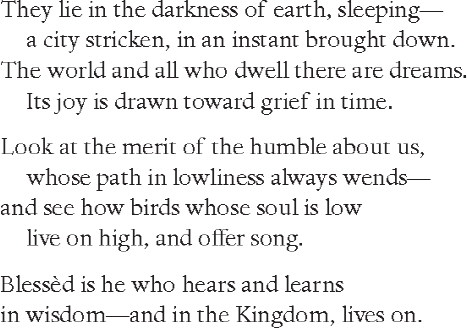YITZHAQ IBN SAHULA
(late thirteenth century)
YITZHAQ IBN SAHULA was a resident of Guadalajara, a town that was close to the centers of the Spanish mystical movements that came to full flower toward the end of the thirteenth century. He appears to have known Moshe de Leon, the principal author of The Zohar, and he himself wrote a qabbalistic commentary on the Song of Songs. There is, however, nothing esoteric about his best-known work, Meshal HaQadmoni (An Ancient Tale), which is grounded in the scientific learning of his day and addressed to the broadest possible readership rather than the limited audience of the Qabbala.
A physician by training and learned in the natural sciences as well as philosophy, Ibn Sahula had been drawn toward secular poetry in his youth, but in his thirty-seventh year, as he notes in the introduction to Meshal HaQadmoni, “a spirit came across him and he saw the evil of his ways . . . and he said: I have sinned, and my sins have been written with an iron pen / where now can I turn?” He composed his tale in that spirit of contrition, couching his stories in the guise of ancient lore in order to enhance their appeal for an audience which, as he saw it, had only a tenuous link to Jewish tradition and was, instead, drawn to the foreign literature of the day (both European and Arabic). His aim, he wrote, was “to remove the books of Homer, heretics, and aesthetes from their hearts.”
Ibn Sahula did, however, make use of foreign elements to sweeten the pill, and he based Meshal HaQadmoni on Arabic, Persian, and Indian models, such as Kalila and Dimna and Tales of Sendebar (The Seven Sages of Rome). As in those works, his characters are animals, but throughout the five parts of the book—which treat Wisdom and Knowledge, Repentance, Good Counsel, Humility, and Awe—they deliver sermons drawing on traditional Jewish sources. Despite the contempt for the reader that sometimes comes through Ibn Sahula’s work, Meshal HaQadmoni soon became extremely popular and was even published in Yiddish, in nine editions, beginning in the seventeenth century.
Part and parcel of Ibn Sahula’s principled rejection of the foreign was, perhaps, the author’s choice to include very few metrical poems in his narrative—as he saw the use of quantitative meters as alien to the spirit of Hebrew. Meshal HaQadmoni contains just twelve poems, five of them in the preface; all are far inferior to the poems found in earlier collections of rhymed Hebrew prose by Alharizi, Ben Ya‘aqov, and others. Ibn Sahula’s Hebrew prose, on the other hand, is vivid and lithe.

THE CYNIC SPEAKS

ON HUMILITY
